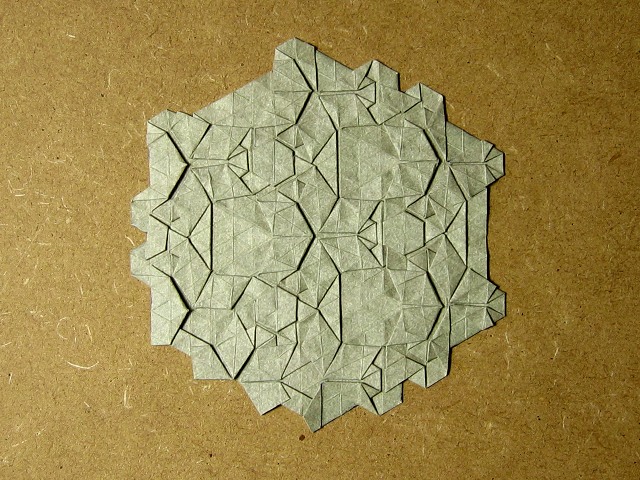
Two days ago Eric did something very naughty. He wrote:
So it's been a fair while since I've made or posted any crease patterns, and I thought it was about time I did so.
To that end, I've made a CP for a design called "Rhombic Flowers" which is, surprisingly, a tessellation...
http://www.origamite...
For those of you who enjoy folding tessellations, please give it a try and let me know what you think. It's never actually been folded, so I'm pretty curious to see what it looks like when fully completed.
Very naughty indeed! I'm so bad with not accepting such a challenge. So on that day I started my first attempt. You know where this is leading, right? I started with a 64 division triangle grid and added all the rhombi - so far so good. But couldn't quite figure out how to collapse model. I got halfway there, and then gave up. Today I looked at it again and decided that transparent paper wasn't the best choice for the model, and that really I should try a smaller version first. This was a good chance to try using elephant hide. I'd never worked with it before, but heard it was really nice for tessellations. I used the same size of paper, but went for a 32 division triangle grid. And this is the result. I have to admit I drew in the crease lines on the back -- and that was a great help. And you can't tell when looking at the front. So I'm not showing my usual "front and back" of a tessellation. I should have used a pencil rather than a pen - or not mess up a couple of times with drawing in the creases. Ah...
Anyway, the model's quite nice, although I'm still not as comfortable with making rhombic twists as I'd like. I think they're the hardest of the bunch (triange, square, rhombic, hexagon). And you can learn from it at least this: drawing in creases often helps -- and is absolutely acceptable.
Paper: hexagon from a 19.5cm square of elephant hide (side length: 9.7cm)
Model: hexagon with side length 6.9cm

Comments
Submitted by Anonymous (not verified) on 13 August 2009 - 6:05pm Permalink
a tip for collapsing tessellation crease patterns
if there are more valley folds than mountain folds at a point, that point is concave
if there are more mountain folds at a point, that point is convex
What i usually do is fold sum of the creases and try to "semi- collapse" it at the same time. Hopefully this will help.
-Daniel
Submitted by Anonymous (not verified) on 2 October 2014 - 2:28am Permalink
Are you by any chance Daniel
Are you by any chance Daniel Kwan? If not, look him up. He's reeeely cool.
Submitted by Kuhu (not verified) on 16 May 2011 - 3:39pm Permalink
I recently started making
I recently started making tessellations- I learnt them from you!
So right now I find it a little difficult to follow crease patterns.. especially the ones without the guideline grid..
How do I do a rhombic twist??
Submitted by Sara on 2 June 2011 - 6:10am Permalink
Instructions soon?
I have vague plans to make some videos on more tessellation techniques - the rhombic twist would be one of them.
-- Sara
Add new comment